三年级英语上册第二单元
《第二单元Let's Know More》教学设计湘少版(三起)(2024)小学英语三年级上册
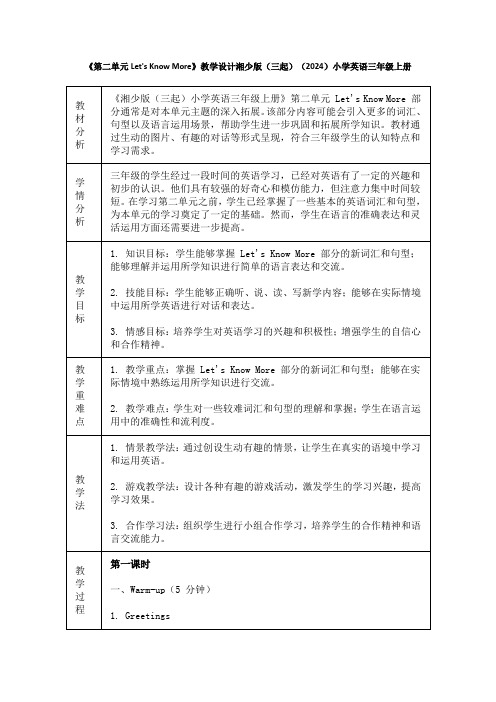
第一课时
一、Warm-up(5 分钟)
1. Greetings
教师用英语与学生打招呼,如 “Good morning/afternoon, boys and girls!”“How are you?” 等,引导学生用英语回应。
设计意图:营造英语学习氛围,复习日常问候语,为后续教学活动做好铺垫。
3. Practice new words and sentences
教师带领学生朗读新词汇和句型,纠正学生的发音。然后,教师通过各种方式让学生练习新内容,如快速认读、小组竞赛等。
设计意图:通过反复练习,帮助学生掌握新的词汇和句型。
三、Practice(15 分钟)
1. Listen and repeat
3. Guessing game
教师准备一些与新学内容相关的图片或实物,让学生通过描述来猜测是什么。
设计意图:增加课堂的趣味性,同时巩固学生对新学内容的掌握。
四、Summary(5 分钟)
1. 教师带领学生回顾本节课所学的内容,包括新词汇和句型。
2. 教师对学生的表现进行评价,表扬积极参与的学生,鼓励其他学生继续努力。
板书设计
Unit 2 Let's Know More
New words:...
New sentences:...
教学反思
在本单元的教学中,通过情景教学法、游戏教学法和合作学习法等多种教学方法的运用,激发了学生的学习兴趣,提高了学生的学习积极性。在教学过程中,注重引导学生在实际情境中学习和运用英语,培养了学生的语言运用能力和合作意识。同时,通过拓展知识和小组活动,拓展了学生的知识面,培养了学生的创造力和团队精神。
学情分析
三年级的学生经过一段时间的英语学习,已经对英语有了一定的兴趣和初步的认识。他们具有较强的好奇心和模仿能力,但注意力集中时间较短。在学习第二单元之前,学生已经掌握了一些基本的英语词汇和句型,为本单元的学习奠定了一定的基础。然而,学生在语言的准确表达和灵活运用方面还需要进一步提高。
英语第二单元三年级上册
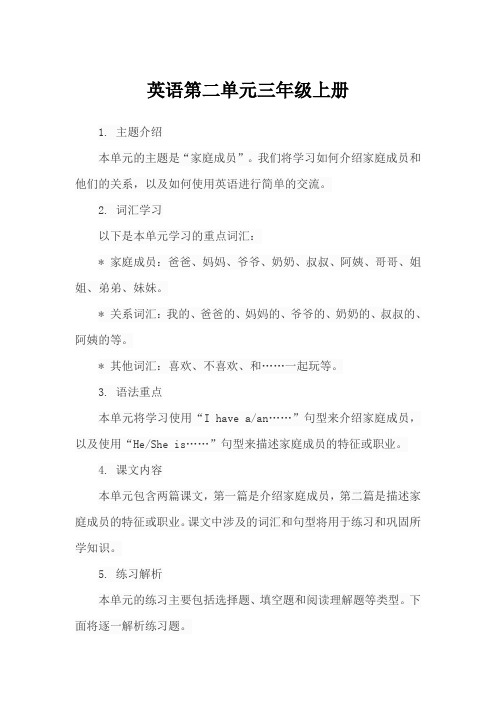
英语第二单元三年级上册1. 主题介绍本单元的主题是“家庭成员”。
我们将学习如何介绍家庭成员和他们的关系,以及如何使用英语进行简单的交流。
2. 词汇学习以下是本单元学习的重点词汇:* 家庭成员:爸爸、妈妈、爷爷、奶奶、叔叔、阿姨、哥哥、姐姐、弟弟、妹妹。
* 关系词汇:我的、爸爸的、妈妈的、爷爷的、奶奶的、叔叔的、阿姨的等。
* 其他词汇:喜欢、不喜欢、和……一起玩等。
3. 语法重点本单元将学习使用“I have a/an……”句型来介绍家庭成员,以及使用“He/She is……”句型来描述家庭成员的特征或职业。
4. 课文内容本单元包含两篇课文,第一篇是介绍家庭成员,第二篇是描述家庭成员的特征或职业。
课文中涉及的词汇和句型将用于练习和巩固所学知识。
5. 练习解析本单元的练习主要包括选择题、填空题和阅读理解题等类型。
下面将逐一解析练习题。
选择题:选择题主要是检验学生对所学知识的掌握程度,帮助学生发现自己不熟悉或者没掌握的词汇和语法点。
填空题:填空题主要是让学生根据上下文填写合适的单词或短语,锻炼学生的阅读理解和组织语言的能力。
阅读理解题:阅读理解题主要是让学生通过阅读短文,理解文章内容,并回答相关问题。
这种题型可以帮助学生提高阅读速度和理解能力。
6. 学习建议对于本单元的学习,建议学生多读多练,加强口语和听力训练。
同时,学生可以尝试用英语介绍自己的家庭成员,提高实际应用能力。
此外,学生还可以通过参加英语角、观看英语电影等方式拓展自己的英语知识面。
7. 相关文化在西方文化中,家庭成员之间的关系比较简单,通常只有父母和子女,很少有复杂的亲戚关系。
因此,在用英语介绍家庭成员时,通常只需要介绍父母和子女即可。
此外,在西方文化中,家庭成员之间的称呼比较简单,通常只有“Dad”、“Mom”、“Son”和“Daughter”等称呼。
三年级英语上册unit2
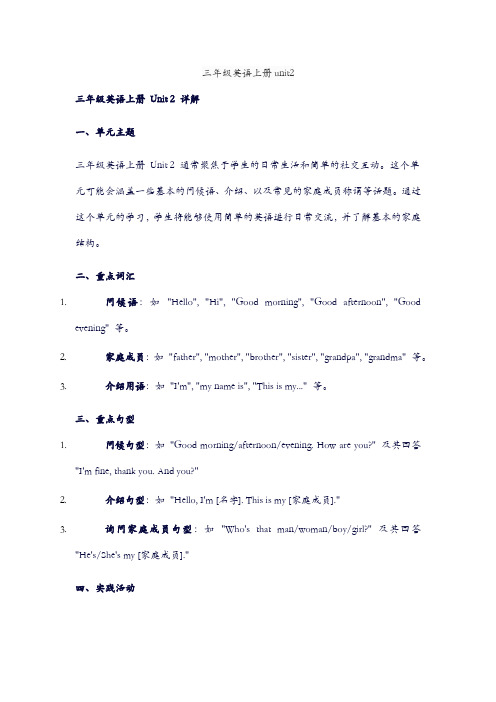
三年级英语上册unit2三年级英语上册Unit 2 详解一、单元主题三年级英语上册Unit 2 通常聚焦于学生的日常生活和简单的社交互动。
这个单元可能会涵盖一些基本的问候语、介绍、以及常见的家庭成员称谓等话题。
通过这个单元的学习,学生将能够使用简单的英语进行日常交流,并了解基本的家庭结构。
二、重点词汇1.问候语:如"Hello", "Hi", "Good morning", "Good afternoon", "Goodevening" 等。
2.家庭成员:如"father", "mother", "brother", "sister", "grandpa", "grandma" 等。
3.介绍用语:如"I'm", "my name is", "This is my..." 等。
三、重点句型1.问候句型:如"Good morning/afternoon/evening. How are you?" 及其回答"I'm fine, thank you. And you?"2.介绍句型:如"Hello, I'm [名字]. This is my [家庭成员]."3.询问家庭成员句型:如"Who's that man/woman/boy/girl?" 及其回答"He's/She's my [家庭成员]."四、实践活动1.角色扮演:学生可以分组进行角色扮演活动,模拟日常生活中的问候和介绍场景。
三年级英语上册第二单元人教版词汇表
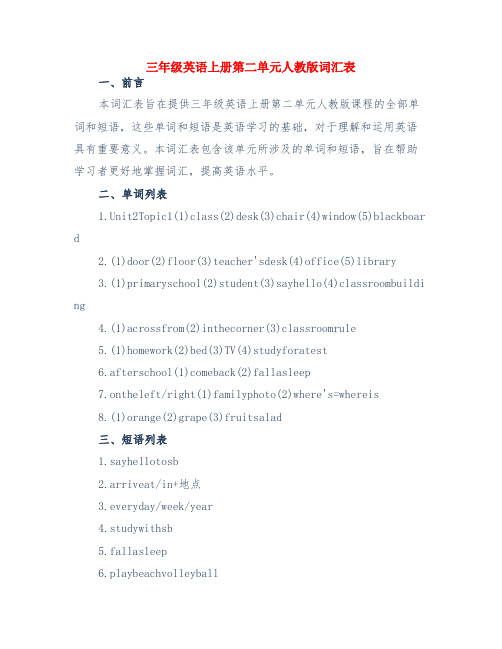
三年级英语上册第二单元人教版词汇表一、前言本词汇表旨在提供三年级英语上册第二单元人教版课程的全部单词和短语,这些单词和短语是英语学习的基础,对于理解和运用英语具有重要意义。
本词汇表包含该单元所涉及的单词和短语,旨在帮助学习者更好地掌握词汇,提高英语水平。
二、单词列表1.Unit2Topic1(1)class(2)desk(3)chair(4)window(5)blackboar d2.(1)door(2)floor(3)teacher'sdesk(4)office(5)library3.(1)primaryschool(2)student(3)sayhello(4)classroombuildi ng4.(1)acrossfrom(2)inthecorner(3)classroomrule5.(1)homework(2)bed(3)TV(4)studyforatest6.afterschool(1)comeback(2)fallasleep7.ontheleft/right(1)familyphoto(2)where's=whereis8.(1)orange(2)grape(3)fruitsalad三、短语列表1.sayhellotosb2.arriveat/in+地点3.everyday/week/year4.studywithsb5.fallasleep6.playbeachvolleyballetothebeach8.whatelse?9.thankstosb/sth四、单词记忆方法除了直接记忆外,还有一些有效的单词记忆方法,如发音记忆、联想记忆、语境记忆等。
通过这些方法,可以更好地记住单词的发音、拼写和含义。
五、使用建议1.学生在学习单词时,应该注重发音和拼写,避免出现发音不准或拼写错误的问题。
同时,也要注意单词的用法和语境,确保能够正确理解和表达意思。
2.学生可以通过制作单词卡片、使用单词软件等方式进行复习和巩固,加深对单词的记忆和理解。
三年级上册英语第二单元知识点

三年级英语上册第二单元重点知识Unit2Different families不同的家庭一、词汇:mum mother妈妈dad father爸爸grandma grandmother奶奶/外婆grandpa grandfather爷爷/外公me我sister妹妹family家庭have有big大的small小的cousin堂兄弟姐妹/表兄弟姐妹brother兄弟baby婴儿uncle叔叔aunt阿姨some一些egg鸡蛋nest巢fish鱼beef牛肉girl女孩pig小猪hot热的hat帽子二、句型:1.Mum!Dad!This is my friend,Sarah Miller.妈妈爸爸,这是我的朋友Sarah Miller.2.This is my grandma/grandpa.这是我的奶奶/爷爷。
3.This is my family.这是我的家人。
This is me.这是我。
4.I have a big/small family.我有一个大/小家庭。
5.--How do you do.你好。
--How do you do.你好。
6.--How are you?你过得好吗?--Fine,thank you.我很好,谢谢。
7.Where are you?你在哪里?8.--Nice to meet you.见到你很高兴。
--Nice to meet you,too.见到你我也很高兴。
9.Sarah,you have a big family.Sarah,你有一个大家庭。
10.--Is this your sister?这是你的妹妹吗?--No,it’s my cousin.不,这是我的表妹。
11.--Is that your brother?那是你的哥哥吗?--Yes,it is.是的,他是。
12.My family is big.我的家很大。
13.I have an uncle/aunt.我有一个叔叔/阿姨。
三年级英语上册第二单元的必备知识点

三年级英语上册第二单元的必备知识点一、词汇知识点1. 颜色词汇red 红色;红色的green 绿色;绿色的yellow 黄色;黄色的blue 蓝色;蓝色的black 黑色;黑色的brown 棕色;棕色的white 白色;白色的orange 橙色;橙色的这些颜色词汇是第二单元的核心,学生需要熟练掌握它们的发音、拼写及基本用法。
2. 其他常用词汇OK 好;行mum 妈妈(英式英语)mom 妈妈(美式英语)book 书籍bag 书包pencil 铅笔pen 钢笔eraser 橡皮crayon 蜡笔sharpener 卷笔刀schoolbag 书包(更正式的说法)pencil box 铅笔盒这些词汇在日常学习和生活中非常实用,学生应该能够准确识别和运用它们。
二、句型知识点1. 介绍他人This is ... 句型。
例如:“This is Miss Green. 这是格林小姐。
”2. 问候与回答Good morning/afternoon, ... 及其回答。
例如:“Good morning, Miss Green. 早上好,格林小姐。
”Nice to meet you. 及其回答“Nice to meet you, too.”3. 颜色表达I see [color]. 例如:“I see red. 我看到红色。
”Show me [color]. 例如:“Show me green. 给我看看绿色。
”4. 涂色指令Colour it [color]! 例如:“Colour it brown! 把它涂成棕色吧!”5. 询问与回答询问物品归属:“Is this your ...?”及其回答 “Yes, it is./No, it isn't.”询问物品数量:“How many ... do you have?”及其回答“I have ...”。
例如:“How many books do you have? I have three books.”6. 表达喜好I like [物品]. 例如:“I like blue pencils. 我喜欢蓝色的铅笔。
2024新版牛津英语三年级上册 Unit2 第二单元练习题
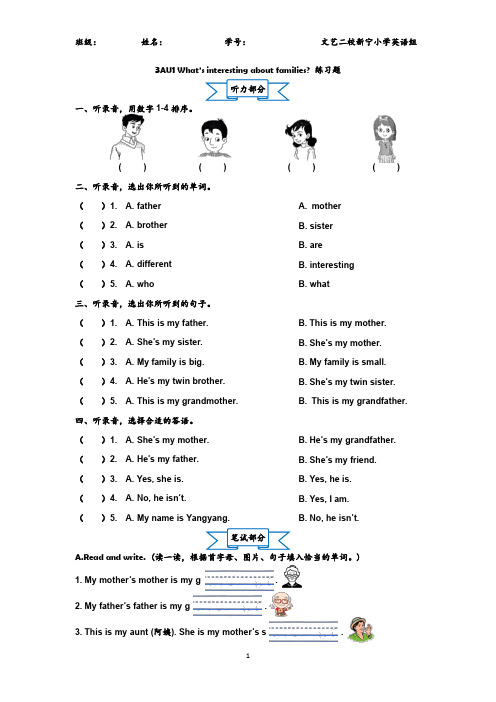
3AU 1What’s interestingabout families?练习题听力部分一、听录音,用数字1-4排序。
()()()()二、听录音,选出你所听到的单词。
()1. A.father ()2. A.brother ()3. A.is ()4. A.different ()5. A.who三、听录音,选出你所听到的句子。
()1. A.This is my father.()2. A.She’s my sister.()3. A.My family is big.()4. A.He’s my twin brother.()5. A.This is my grandmother.四、听录音,选择合适的答语。
()1. A.She’s my mother.()2. A.He’s my father.()3. A.Yes,she is.()4. A.No,he isn’t.()5. A.My name is Yangyang.笔试部分A.Read and write.(读一读,根据首字母、图片、句子填入恰当的单词。
)1.My mother’s mother is my g .2.My father’s father is my g.3.This is my aunt (阿姨).She is my mother’s s.B.This is my mother.B.She’s my mother.B.My family is small.B.She’s my twin sister.B.This is my grandfather.A.motherB.sister B.are B.interesting B.whatB.He’s my grandfather.B.She’s my friend.B.Yes,he is.B.Yes,I am.B.No,he isn’t.4.This is my uncle (叔叔).He is my father’s b .5.I have a big f.B.Read and choose.(读一读,根据情境选择正确的选项。
三年级上册英语第二单元家庭树
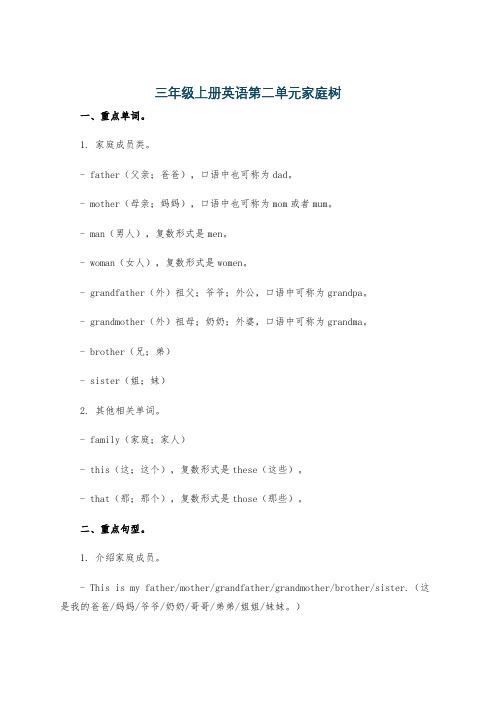
三年级上册英语第二单元家庭树一、重点单词。
1. 家庭成员类。
- father(父亲;爸爸),口语中也可称为dad。
- mother(母亲;妈妈),口语中也可称为mom或者mum。
- man(男人),复数形式是men。
- woman(女人),复数形式是women。
- grandfather(外)祖父;爷爷;外公,口语中可称为grandpa。
- grandmother(外)祖母;奶奶;外婆,口语中可称为grandma。
- brother(兄;弟)- sister(姐;妹)2. 其他相关单词。
- family(家庭;家人)- this(这;这个),复数形式是these(这些)。
- that(那;那个),复数形式是those(那些)。
二、重点句型。
1. 介绍家庭成员。
- This is my father/mother/grandfather/grandmother/brother/sister.(这是我的爸爸/妈妈/爷爷/奶奶/哥哥/弟弟/姐姐/妹妹。
)- That is my family.(那是我的家庭。
)2. 区分单复数。
- These are my parents.(这些是我的父母。
)- Those are my grandparents.(那些是我的(外)祖父母。
)三、语法点。
1. this和that的用法。
- this用于指代离说话者较近的人或事物,that用于指代离说话者较远的人或事物。
例如:- This is my book.(这本书在我旁边,离我近。
)- That is his pen.(那支笔离我远一些。
)- this和that的复数形式分别是these和those,用法类似。
2. be动词的用法。
- 在介绍单个的家庭成员时,be动词用is,如This is my mother.- 在介绍多个家庭成员时,be动词用are,如These are my brothers.四、趣味学习方法。
人教版三年级上册英语第二单元课文翻译及音标
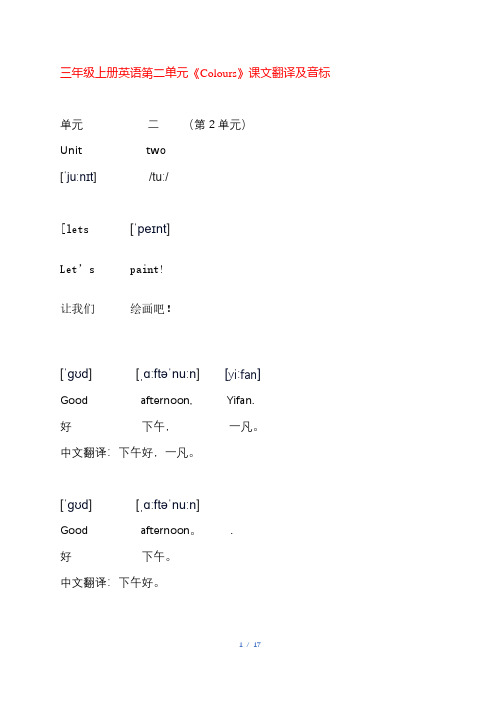
repeat
and
chant .
重复
并
唱一唱
[ænt] Ant 蚂蚁 [ˈbʊk] Book 书 [ˈkæt] Cat 猫
[ˈæpl] apple 苹果 [ˈbæɡ] bag 包 [ˈkreɪən] crayon n. (名词). 彩色蜡笔或粉笔
[ˈdɒɡ] Dog 狗
[dʌk] duck 鸭子
7 / 17
三年级上册英语第二单元《Colours》课文翻译及音标
单元 Unit [ˈjuːnɪt]
二 (第 2 单元) two /tuː/
[lets Let’s 让我们
[ˈpeɪnt] paint! 绘画吧!
[ˈɡʊd]
[ˌɑːftəˈnuːn]
Good
afternoon,
好
下午,
中文翻译:下午好,一凡。
[yiːfan] Yifan. 一凡。
涂色
它 adj. 棕色的;褐色的;. n. 褐色;棕色;. v. 变成棕色.
中文翻译:将它涂成棕色的。
[əʊˈkeɪ] OK! 好的 [ˈblæk] Black 黑色
[ˈwaɪt] white 白色
[ˈɒrɪndʒ] orange 橙色
[ˈbraʊn] brown 棕色
[lets du:] Let’s do 让我们 做一做
[ænd] [ˈɒrɪndʒ] [ænd] [ˈbluː]
and orange and blue,
和
橙色
和
蓝色,
/aɪ/ [kæn] [sɪŋ] [ə] [ˈreɪnbəʊ]
I can sing a rainbow, 我 能 歌唱 一个 彩虹,
[sɪŋ] [ə] [ˈreɪnbəʊ] [naʊ]
人教版pep三年级英语上册第二单元教案
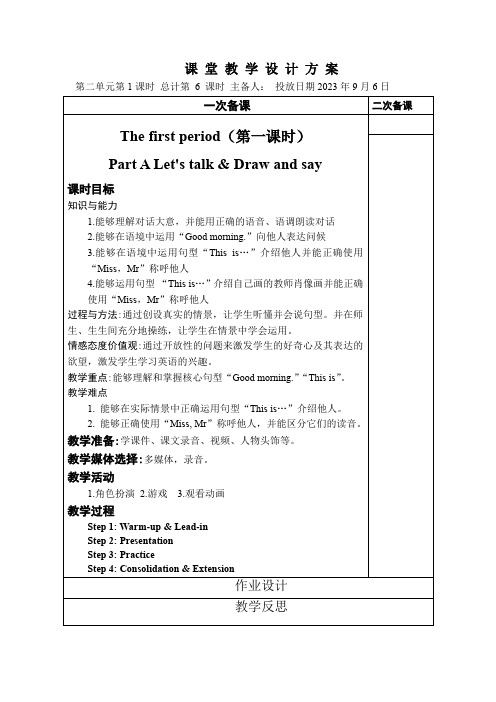
4.能够运用句型“This is…”介绍自己画的教师肖像画并能正确使用“Miss,Mr”称呼他人
过程与方法:通过创设真实的情景,让学生听懂并会说句型。并在师生、生生间充分地操练,让学生在情景中学会运用。
情感态度价值观:通过开放性的问题来激发学生的好奇心及其表达的欲望,激发学生学习英语的兴趣。
课时目标
知识与能力
1.能够找出并能听、说、读、写图片中的字母
2.能够听、说、认读表示颜色的单词“red, green, yellow, blue, black, white, orange, brown”
3.能够独立完成Let's check板块的练习
4.能够听懂、跟唱歌曲,并能创编新的歌曲
过程与方法
The fifth period(第五课时)
Part B Let’s learn & Let’s do
课时目标
知识与能力
1.能够听、说、认读颜色单词“black, white, orange, brown”
2.能够听懂该板块的指令,并能够按照指令做出相应的动作
过程与方法
通过让学生观察图片说出不同的颜色以及快速反应的游戏,让学生操练本单元所学的颜色单词。
情感态度价值观:通过让学生寻找生活中与字母形状相同的物品来加强学习的趣味性,强化学生对字母知识的记忆。
教学重点:能够听、说、读、写字母Aa, Bb, Cc, Dd,并初步掌握3个辅音字母作为单词首字母时的发音。
教学难点:能够掌握这四个字母的笔顺、书写格式及其在相关例词中的发音。
教学准备:教学课件、课文录音、视频、字母卡片等。
教学媒体选择:多媒体,录音。
三年级上册英语第2单元

三年级上册英语第二单元知识点总结一、词汇知识点1基础词汇book:书籍。
例句:I have a new book.(我有一本新书。
)bag:书包。
例句:Put your books in your bag.(把你的书放进书包里。
)pencil:铅笔。
例句:Can I borrow your pencil?(我可以借你的铅笔吗?)pen:钢笔。
例句:Use your pen to write.(用你的钢笔写字。
)eraser:橡皮。
例句:Don't forget your eraser.(别忘了你的橡皮。
)crayon:蜡笔。
例句:Color the picture with your crayons.(用你的蜡笔给这幅画上色。
)2拓展词汇sharpener:卷笔刀。
例句:Use the sharpener to sharpen your pencils.(用卷笔刀削尖你的铅笔。
)schoolbag:书包(更正式的说法)。
例句:Put all your school supplies in your schoolbag.(把你的学习用品都放进书包里。
)pencil box:铅笔盒。
例句:I have a pencil box with manycolors.(我有一个五颜六色的铅笔盒。
)三、语法知识点1形容词性物主代词my:我的。
例句:This is my book.(这是我的书。
)your:你的。
例句:Is this your pencil?(这是你的铅笔吗?)his/her:他的/她的。
例句:He has a big book. She has a small book.(他有一本大书。
她有一本小书。
)2名词的复数形式books:书籍(book的复数形式)。
例句:I have many books.(我有很多书。
)pencils:铅笔(pencil的复数形式,不常用,通常使用pens)。
三年级上册英语书第二单元单词
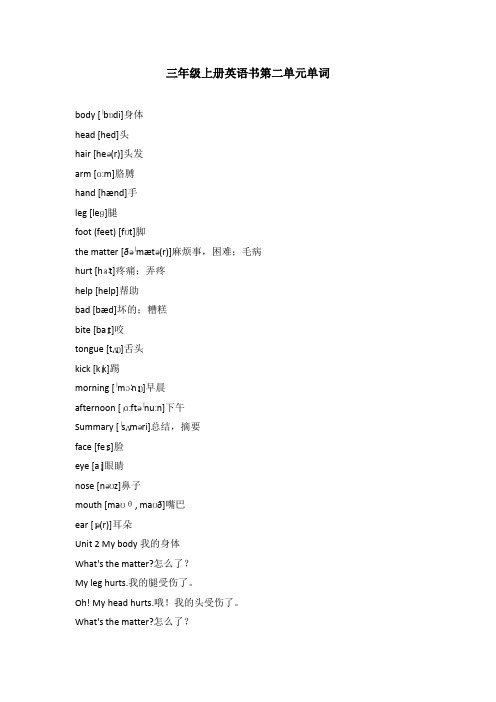
三年级上册英语书第二单元单词body [ˈbɒdi]身体head [hed]头hair [heə(r)]头发arm [ɑːm]胳膊hand [hænd]手leg [leɡ]腿foot (feet) [fʊt]脚the matter [ðəˈmætə(r)]麻烦事,困难;毛病hurt [hɜːt]疼痛;弄疼help [help]帮助bad [bæd]坏的;糟糕bite [baɪt]咬tongue [tʌŋ]舌头kick [kɪk]踢morning [ˈmɔːnɪŋ]早晨afternoon [ˌɑːftəˈnuːn]下午Summary [ˈsʌməri]总结,摘要face [feɪs]脸eye [aɪ]眼睛nose [nəʊz]鼻子mouth [maʊθ, maʊð]嘴巴ear [ɪə(r)]耳朵Unit 2 My body我的身体What's the matter?怎么了?My leg hurts.我的腿受伤了。
Oh! My head hurts.哦!我的头受伤了。
What's the matter?怎么了?My foot hurts.我的脚受伤了。
Lesson 1第一课。
A Look, listen and chant.看,听并齐声唱。
head头hair头发arm手臂hand手leg腿body身体foot脚I have a body.我有一个身体。
Me too, me too!我也是,我也是!I have two heads.我有两个头!Not me, not me!我没有,我没有!I have black hair.我有黑头发!Me too, me too!我也是,我也是!I have four arms.我有四只手臂。
Not me, not me!我没有,我没有!I have four hands.我有四只手。
Not me, not me!我没有,我没有!I have two legs.我有两条腿。
2024年人教版三年级上册英语第二单元课后练习题(含答案和概念)

2024年人教版三年级上册英语第二单元课后练习题(含答案和概念)试题部分一、选择题:1. Which letter is the first in the English alphabet?A. AB. BC. CD. DA. catB. dogC. birdD. book3. What is the opposite of "big"?A. smallB. tallC. shortD. fat4. Which of the following is a fruit?A. appleB. carC. penD. desk5. What color is the sky on a sunny day?A. redB. blueC. greenD. yellow6. Which word means "not hot"?A. coldB. warmC. coolD. hotA. fiveB. fifteenC. fiftyD. fiftyfive8. What is the plural form of "cat"?A. catsB. catC. catesD. catess9. Which of the following is a verb?A. runB. bookC. tableD. happy10. What is the past tense of "go"?A. goesB. goneC. wentD. going二、判断题:1. The sun rises in the west. ( )2. "Dog" and "cat" are both animals. ( )3. English is the only language spoken in the world. ( )4. Apples are a kind of vegetable. ( )5. The sky is green on a cloudy day. ( )6. "Run" and "jump" are both verbs. ( )7. The plural form of "mouse" is "mouses". ( )8. A cat can fly. ( )9. The opposite of "hot" is "cold". ( )10. "I am" and "you are" are both present tense. ( )三、填空题:1. The English alphabet has _______ letters.2. "I", "you", "he", "she", and "it" are all _______ pronouns.3. A noun is a word that represents a _______ or a_______.4. The past tense of "eat" is _______.5. We use "a" before a word that _______ with a consonant sound.6. The opposite of "old" is _______.7. "Do" and "does" are used to form _______ tense questions.8. The plural form of "child" is _______.9. "Thank you" is a polite way to say _______.10. In English, we say "_______" when we meet someone in the morning.11. The third month of the year is _______.12. "What's your name?" is a question asking forsomeone's _______.13. "I can" means that you are _______ to do something.14. "I like" is followed a _______ to show what you enjoy.15. "Please" is a word we use to make a request _______.16. "No" is the opposite of _______.17. "How are you?" is a question to ask about someone's_______.18. "Where is" is used to ask about the _______ of something.19. "My" is a word that shows _______.20. "The" is a word that we use before a _______ or an adjective to specify.四、简答题:1. What is the difference between "a" and "an"?2. How do you form the plural of most nouns in English?3. What is a verb and give an example.4. Explain the difference between "I do" and "I am doing".5. What is an adjective and how is it used in a sentence?6. Write a sentence using the word "because".7. How do you ask a question in the present continuous tense?8. What is the past tense of "write"?9. Explain how to make a sentence negative in English.10. What is the difference between "I like" and "I would like"?一、选择题答案:1. A2. A3. A4. A5. B6. C7. A8. A9. A10. C二、判断题答案:1. ×2. √3. ×4. ×5. ×6. √7. ×8. ×9. √10. √三、填空题答案:1. twentysix2. subject3. person; place4. ate5. begins6. young7. present8. children9. thanks10. Good morning11. March12. name13. able14. noun15. polite16. yes17. health18. location19. possession20. noun四、简答题答案:1. "A" is used before words that begin with a consonant sound, while "an" is used before words that begin with a vowel sound.2. Most nouns form the plural adding s or es to the singular form.3. A verb is a word that expresses an action or a state of being. Example: "run", "is".4. "I do" is in the simple present tense and "I am doing" is in the present continuous tense.5. An adjective is a word that describes a noun. Example: "The red car is fast."6. I went to the store because I needed to buy milk.7. To ask a question in the present continuous tense, use the structure "am/is/are + subject + verbing". Example: "Are you reading a book?"8. The past tense of "write" is "wrote".9. To make a sentence negative, add "not" after the first auxiliary verb. Example: "I do not like apples."10. "I like" expresses a general preference, while "I would like" is more polite and often used to make a request.Alphabet and basic grammar rulesPronouns and their usesNouns, verbs, adjectives, and their functions in sentencesTense formation and usageArticle usage (a, an, the)Plural formation of nounsPoliteness in languageOpposites and adjectivesQuestion formation in different tenses各题型知识点详解和示例:选择题:Test students' knowledge of basic vocabulary, grammar rules, and sentence structure.Example: Knowing the correct answer to "What is the opposite of 'hot'?" (cold) demonstrates understanding of antonyms.判断题:Assess students' understanding of factual information and grammatical concepts.Example: Correctly identifying that "The sun rises in the west." is false shows knowledge of地理 concepts.填空题:Evaluate students' ability to recall and apply vocabulary and grammatical structures.Example: Filling in "The opposite of 'old' is _______." with "young" tests knowledge of antonyms.简答题:Measure students' ability to explain and use grammatical concepts in context.Example: Explaining the difference between "I do" and "I am doing" demonstrates an understanding of tenses.试题部分一、选择题:1. Which letter is the first in the English alphabet?A. AB. BC. CD. EA. catB. dogC. bookD. pen3. What is the opposite of "big"?A. smallB. tallC. shortD. fat4. Which of the following is a fruit?A. appleB. carC. chairD. book5. Which word means "not hot"?A. coldB. warmC. coolD. hot6. What is the plural form of "cat"?A. catsB. catC. catssD. catesA. hungryB. thirstyC. tiredD. all of the above8. What is the past tense of "go"?A. goesB. wentC. goneD. going9. Which of the following is a verb?A. runB. bookC. tableD. happy10. What is the abbreviation for "Doctor"?A. Mr.B. Mrs.C. Dr.D. Miss二、判断题:1. The sun rises in the west. ( )2. "Cat" and "dog" are both animals. ( )3. "He" and "she" are pronouns. ( )4. "Apple" is a kind of fruit. ( )5. "Run" and "jump" are both verbs. ( )6. "Pen" is a noun. ( )7. "I like apples" is a correct sentence. ( )8. "She is reading a book" means she is writing a book. ( )9. "Thank you" is a polite expression. ( )10. "Good morning" is used to greet someone in the evening. ( )三、填空题:1. The English alphabet has _______ letters.2. "I" is a(n) _______ pronoun.3. "She" is a(n) _______ pronoun.4. "They" are _______.5. "Bird" is a(n) _______.6. "Pencil" is a(n) _______.7. "Read" and "write" are both _______.8. "Jump" is the opposite of _______.9. "Hot" is the opposite of _______.10. "Fast" is the opposite of _______.11. "I am" is the first person singular of "_______".12. "You are" is the second person singular of "_______".13. "He/She/It is" is the third person singular of"_______".14. "We are" is the first person plural of "_______".15. "They are" is the third person plural of "_______".16. "I have" is the first person singular of "_______".17. "You have" is the second person singular of "_______".18. "He/She/It has" is the third person singular of"_______".19. "We have" is the first person plural of "_______".20. "They have" is the third person plural of "_______".四、简答题:1. What is the difference between "I" and "me"?2. How do you form the past tense of regular verbs?4. Write a sentence using the word "because".5. What is the difference between "a" and "an"?6. How do you spell the plural form of "child"?7. What is the opposite of "old"?8. Write a sentence using the word "although".9. What is the main difference between "who" and "which"?10. How do you ask someone how they are feeling in English?一、选择题答案:1. A2. A3. A4. A5. C6. A7. D8. B9. A10. C二、判断题答案:1. ×2. √3. √4. √5. √6. √7. √8. ×9. √10. ×三、填空题答案:1. 262. subject3. object4. plural nouns/pronouns5. noun6. noun7. verbs8. sit9. cold10. slow11. am12. are13. is14. are15. are16. have17. have18. has19. have20. have四、简答题答案:1. "I" is a subject pronoun, used when the person is doing the action. "Me" is an object pronoun, used when the person is receiving the action.2. Regular verbs form the past tense adding ed to the base form of the verb.4. I went to the store because I needed to buy milk.5. "A" is used before words that begin with a consonant sound, while "an" is used before words that begin with a vowel sound.6. The plural form of "child" is "children".7. The opposite of "old" is "young".8. I went to the park although it was raining.9. "Who" is used for people, while "which" is used for objects.10. You can ask "How are you feeling?" or "How do you feel?"英语字母表(选择题第1题)代词的使用(选择题第2题,填空题第15题)反义词(选择题第3题,填空题第910题)名词和动词的区分(选择题第49题,填空题第67题)动词时态(选择题第8题,简答题第2题)询问许可(简答题第3题)连词的使用(简答题第48题)冠词的使用(简答题第5题)名词复数形式(简答题第6题)日常用语(简答题第10题)各题型知识点详解和示例:选择题:考查学生对基础英语词汇、语法知识的掌握。
2024三年级上册英语Unit2 Lesson2 教案

2、思维品质
3、学习能力
4、文化意识
对方介绍学习用品时做出礼貌回应,树立爱惜文具,与同伴友好沟通的意识,主动备齐文具,乐于共享文具。
教学重点
掌握核心词汇和句型;在缺少学习用品时运用“Can I use your...?”礼貌地找他人借取,并能在他人向自己借用物品时根据实情运用。
教学难点
对方介绍学习用品时做出礼貌回应,树立爱惜文具,备齐文具,同伴互助,要有学会分享的意识。
小学英语学科教案
执教人:时间:2024年9月
课题名称
人教精通版英语三年级上册Unit2 School things Lesson2
教学目标
1、在听、看、说的活动中,获取Lisa如何向他人借用学习用品及Xin xin如何回应;
2、在歌曲、图片和功能句创造的语境中,学习四个新词汇,并在会演唱歌曲的基础上创编新歌曲;
教学具准备
多媒体课件、单词卡片
教
学
过
程
Step1:Warm up
Enjoy a video about the school things.
提问:Q1:Do you like this things?
Q2:What’s the sing about?
Step2:Presentation
一、Presentation1(创设情景)
3、借助语言支架进行小组合作,向他人借用文具的情境中熟练运用以下核心句式“Can I use your ...、I can’t find my ...、Sure,here you are.”通过观察Lisa的行为,了解自己收拾书包,带齐学习用品的重要性;
4、用所学语言介绍自己的文具及借用他人的学习文具,爱惜自己的文具并有序整理收纳,要有积极向上的态度,在他人有需要时乐云提供帮助;
三年级上册英语书第二单元
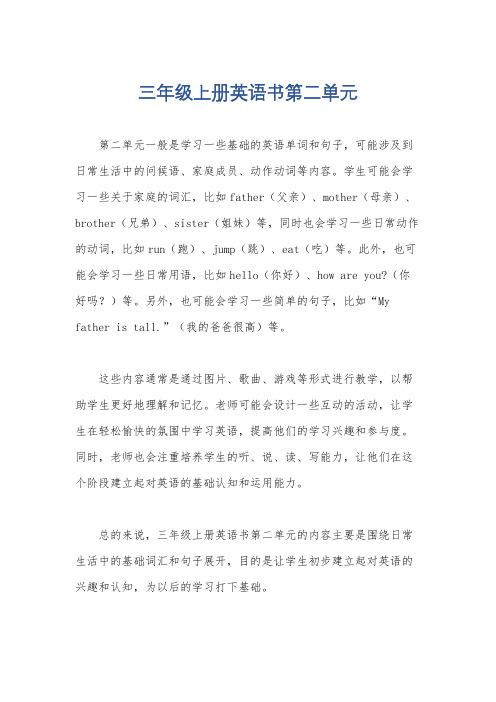
三年级上册英语书第二单元
第二单元一般是学习一些基础的英语单词和句子,可能涉及到日常生活中的问候语、家庭成员、动作动词等内容。
学生可能会学习一些关于家庭的词汇,比如father(父亲)、mother(母亲)、brother(兄弟)、sister(姐妹)等,同时也会学习一些日常动作的动词,比如run(跑)、jump(跳)、eat(吃)等。
此外,也可能会学习一些日常用语,比如hello(你好)、how are you?(你好吗?)等。
另外,也可能会学习一些简单的句子,比如“My father is tall.”(我的爸爸很高)等。
这些内容通常是通过图片、歌曲、游戏等形式进行教学,以帮助学生更好地理解和记忆。
老师可能会设计一些互动的活动,让学生在轻松愉快的氛围中学习英语,提高他们的学习兴趣和参与度。
同时,老师也会注重培养学生的听、说、读、写能力,让他们在这个阶段建立起对英语的基础认知和运用能力。
总的来说,三年级上册英语书第二单元的内容主要是围绕日常生活中的基础词汇和句子展开,目的是让学生初步建立起对英语的兴趣和认知,为以后的学习打下基础。
三年级上册英语第二单元《Colours》课文及翻译人教(音标)(新版)
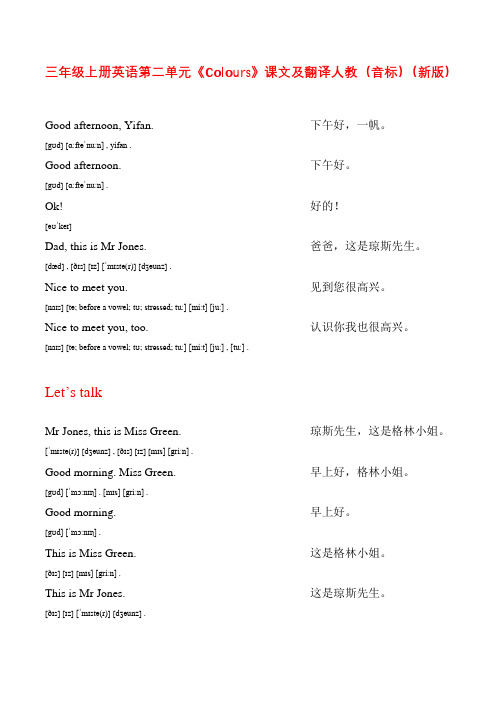
三年级上册英语第二单元《Colours》课文及翻译人教(音标)(新版)Good afternoon, Yifan. 下午好,一帆。
[gʊd] [ɑːftəˈnuːn] , yifan .Good afternoon. 下午好。
[gʊd] [ɑːftəˈnuːn] .Ok! 好的![əʊˈkeɪ]Dad, this is Mr Jones. 爸爸,这是琼斯先生。
[dæd] , [ðɪs] [ɪz] [ˈmɪstə(r)] [dʒəunz] .Nice to meet you. 见到您很高兴。
[naɪs] [tə; before a vowel; tʊ; stressed; tuː] [miːt] [juː] .Nice to meet you, too. 认识你我也很高兴。
[naɪs] [tə; before a vowel; tʊ; stressed; tuː] [miːt] [juː] , [tuː] .Let’s talkMr Jones, this is Miss Green. 琼斯先生,这是格林小姐。
[ˈmɪstə(r)] [dʒəunz] , [ðɪs] [ɪz] [mɪs] [griːn] .Good morning. Miss Green. 早上好,格林小姐。
[gʊd] [ˈmɔːnɪŋ] . [mɪs] [griːn] .Good morning. 早上好。
[gʊd] [ˈmɔːnɪŋ] .This is Miss Green. 这是格林小姐。
[ðɪs] [ɪz] [mɪs] [griːn] .This is Mr Jones. 这是琼斯先生。
[ðɪs] [ɪz] [ˈmɪstə(r)] [dʒəunz] .Let’s learnI see green. 我看到绿色。
[aɪ] [siː] [griːn] .I see red. 我看到红色。
三年级上册英语第二单元知识点

三年级上册英语第二单元知识点三年级上册英语第二单元知识点一、重点单词red 红色;红色的green 绿色;绿色的yellow 黄色;黄色的blue 蓝色;蓝色的black 黑色;黑色的brown 棕色;棕色的white 白色;白色的orange 橙色;橙色的OK 好;行mum 妈妈美式英语:mom 妈妈二、重点句子1.介绍他人:“This is ... ”句型This is Miss Green. 这是格林小姐。
2.第一次见面:A: Nice to meet you. 见到你很高兴。
B: Nice to meet you,too. 见到你也很高兴。
3.早上或上午见面:(一般用于从早上起床到12点之间)Good morning,Miss Green. 早上好,格林小姐。
4.下午见面:(一般用于从午饭后到下午6点之间)Good afternoon,Wu Yifan. 下午好,吴一凡。
5.Colour it brown! 把它涂成棕色吧!(colour 既有动词意义“涂色”,又有名词意义“颜色”)6.I see red. 我看见红色。
7.Show me green.给我看看绿色。
三、知识拓展1.各种不同的称呼Mr,Miss,Ms,Mrs在英语中对不同性别的人,我们要使用不同的称呼。
(1)Mr 意为“先生”,用于称呼男士。
(在这里用于称呼男老师)例:Mr Jones 琼斯先生(琼斯老师)(2)Miss 意为“小姐”,用于称呼未婚女性。
(在这里用于称呼女老师) 例:Miss White 怀特小姐(怀特老师)(3)当我们不确定某位女士的婚姻状况时,我们就可以用Ms(女士)来称呼。
例如:Ms Smart 斯玛特女士/斯玛特老师(4)Mrs 太太;夫人(用于已婚妇女姓名前的尊称)例:Mrs Brown 布朗夫人三年级上册英语第二单元单词表red(红色的)yellow(黄色的)green(绿色的)blue(蓝色的)purple (紫色的)white(白色的)black(黑色的)orange(橙色的)pink(粉色的)brown (棕色的)三年级英语上册unit2练习题一、看中文意思选择正确的单词( )眼睛 A. eye B. ear( )脸 A. nose B.face( )头 A. head B. mouth( )身体 A. body B. leg二、将表示身体各器官的单词填在下图括号内①mouth ②eye ③hand ④face ⑤nose⑥body ⑦head ⑧foot ⑨ear ⑩arm三、读一读,选择正确的答案( )1. This is my arm.A. 这是我的腿。
2024年人教版三年级上册英语第二单元课后练习2(含答案和概念)
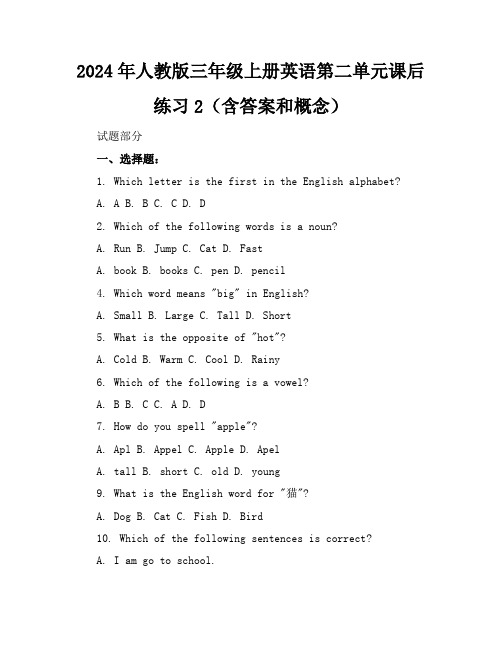
2024年人教版三年级上册英语第二单元课后练习2(含答案和概念)试题部分一、选择题:1. Which letter is the first in the English alphabet?A. AB. BC. CD. D2. Which of the following words is a noun?A. RunB. JumpC. CatD. FastA. bookB. booksC. penD. pencil4. Which word means "big" in English?A. SmallB. LargeC. TallD. Short5. What is the opposite of "hot"?A. ColdB. WarmC. CoolD. Rainy6. Which of the following is a vowel?A. BB. CC. AD. D7. How do you spell "apple"?A. AplB. AppelC. AppleD. ApelA. tallB. shortC. oldD. young9. What is the English word for "猫"?A. DogB. CatC. FishD. Bird10. Which of the following sentences is correct?A. I am go to school.B. I am going to school.C. I go to school.D. I going to school.二、判断题:1. "Dog" and "cat" are both nouns. ( )2. "Run" and "jump" are verbs. ( )3. The English alphabet has 26 letters. ( )4. "Rabbit" is spelled with five letters. ( )5. "Sun" and "moon" are both nouns. ( )6. "Red" and "blue" are adjectives. ( )7. "I" is a vowel in the English alphabet. ( )8. "Apple" and "orange" are fruits. ( )9. "He" and "she" are pronouns. ( )三、填空题:1. The English word for "书" is _______.2. I am _______ years old.3. She _______ to the park every weekend.4. My mother is a _______.5. The sky is _______.6. We _______ to the zoo yesterday.7. _______ is my favorite color.8. I can _______ a bike.9. There are _______ days in a week.10. _______ and _______ are brothers.11. I eat breakfast at _______ in the morning.12. My birthday is in _______.13. She is _______ than her sister.14. I like to _______ in the pool.15. The _______ is shining brightly.16. We learn English in _______.17. I have _______ apples in my bag.18. The cat is _______ the table.19. _______ is the capital of China.20. I want to be a _______ when I grow up.四、简答题:1. What is the difference between a noun and a verb?2. Can you name five colors in English?3. How do you say "I like apples" in English?4. What is the past tense of "go"?5. Write a sentence using the word "because".6. Translate "我喜欢读书" into English.7. What is the opposite of "hot"?8. How many letters are there in the English alphabet?9. Can you name three school subjects in English?10. What is the correct way to say "I am eating an apple" in English?一、选择题答案:1. A2. C3. A4. B5. A6. C7. C8. B9. B10. B二、判断题答案:1. √2. √3. √4. × (Rabbit is spelled with six letters)5. √6. √7. × ("I" is a letter, not a vowel in the context of the alphabet)8. √9. √10. √三、填空题答案:1. book2. seven (example, can vary)4. teacher5. blue6. went7. Blue8. ride9. seven10. Tom; Jack (example names)11. seven thirty12. June13. taller14. swim15. sun16. school17. three18. under19. Beijing20. doctor四、简答题答案:1. A noun is a word that represents a person, place, thing, or idea, while a verb is a word that represents an action or state of being.2. Red, blue, green, yellow, purple (example colors)3. I like apples.5. I stayed home because it was raining.6. I like reading books.7. cold8. 269. Math, Science, History (example subjects)10. I am eating an apple.英语基础知识:字母表、名词、动词、形容词、副词等词性,以及它们的基本用法。
- 1、下载文档前请自行甄别文档内容的完整性,平台不提供额外的编辑、内容补充、找答案等附加服务。
- 2、"仅部分预览"的文档,不可在线预览部分如存在完整性等问题,可反馈申请退款(可完整预览的文档不适用该条件!)。
- 3、如文档侵犯您的权益,请联系客服反馈,我们会尽快为您处理(人工客服工作时间:9:00-18:30)。
三年级英语上册第二单元
教学目标:
1 能听懂、会说How are you? I'm fine./Fine, thank you. 等问候语。
2 通过创设实际情景,让学生能在相应的情景中准确运用以上句型。
3 培养学生正确、自然的模仿语音、语调的能力。
教学重点:How are you? Fine, thank you. 等问候语的学习。
教学难点:
1、How are you? 的得体运用。
2、Fine, thank you.中fine 一词字母i 的发音不容易到位。
教学过程:
热身、复习(Warm-up/Revision)
(1)师生共同唱歌曲Sing an English song together. "Head, shoulders, knees and toes" ,复习人体部位的单词,并集中学生注意力,调动学生学习兴趣。
(2)游戏Do a game. "SIMON SAYS"
指令可以是一二单元Let's do (A/B) 的内容。
(3)师生同唱歌曲"Hello"。
教师可以边唱边用手势示意学生,将歌曲中的人名改为同班同学的名字。
(4)教师用头饰介绍人物。
例如:教师举起Mr. Black的头饰说:This is Mr. Black. 然后戴上Mr. Black的头饰说:Good morning, boys and girls. I'm Mr. Black. Nice to meet you . 让学生回答:Nice to meet you ,too. 用同样的方法介绍Miss White, Miss Green ,并要求学生和这些人物打招呼。
(5)请三个学生扮演Mr. Black, Miss White, Miss Green ,用唱歌的形式互相问候。
"Hello"
呈现新课(Presentation)
(1)师生观看教学课件。
课件内容为Let's talk/A 的内容。
教师利用与教材内容相同的教学课件,使学生一目了然,既了解了句型的含义,又了解句型运用的情景。
(2)再次观看课件,教师提问:T: What are they doing? 他们在干什么?S: 在打招呼。
(3)教师演示Let's talk/A 的内容,使学生进一步理解对话。
方法为:教师左手举起Miss White 的头饰,右手举起Miss Green 的头时,用不同声调引出对话内容。
在此次演示活动中,教师强调Nice to meet you . Nice to meet you, too. 两句话。
(4)教师提问:Mr. Black 和Miss Green 是怎样用英语打招呼的。
能力强的学生或学过英语的学生尝试性的说How are you? Fine, thank you.
(5)听本课时Let's talk/A 教学配套的录音带,学生跟读并模仿发音。
教师注意带读不易掌握的读音,如:Fine, thank you. 一句中fine 中的元音字"i" 的读音是[ai] ,提示学生口型要略大些。
而thank一词中的th 在发音时,要让舍尖处于上下齿之间,教师可以夸大口型,让学生了解发音方法。
教师要适当纠正,切不可一味的纠正发音,打击孩子学习的积极性。
(6)第三次观看Let's talk/A 部分的教学课件。
使学生进一步了解对话内容和含义。
在此基础上告诉学生,How are you? 与以前所学Hello./Hi . 等问候语不同点在于:How are you? 是用于熟人之间有一段时间未见面,或是对方身体欠佳,或是较正式的向别人打招呼等场合。
因此,同学们不必每次见面都问How are you? ,每天见面时,只要说Hello. 和Hi .就可以了。
(7)趣味操练游戏----传口令
教师分别在每组第一个学生的耳边轻轻的说:How are you? Fine, thank you. 学生依次传
递。
以传递准确,速度又快的为胜。
趣味操练(Practice)
(1)游戏
六至七人一组,做开火车的游戏。
教师在每组选出一名"质量监督员",监督每个同学提问的完整性和正确率。
从第一个学生开始Hi/Hello/Good morning, A . How are you? 第二个学生回答I'm fine./Fine, thank you. 并提问How are you? 以此类推。
(A代表学生姓名)。
(2)学生戴上Mr. Black, Miss White, Miss Green 的头饰,分角色练习、表演对话。
(3)游戏
做Let's play 部分的活动,教师让学生按教材的方法两人一小组的活动,两人相互击掌问好,如:
S1: Hi/Hello/Good morning, A . How are you?
S2: I'm fine./Fine, thank you. (A代表学生姓名)。
在同桌练习之后,在进行前、后两人一组练习。
目的是再次强调练习Let's talk 部分的内容。
练习时训练学生彼此倾听发音,纠正发音,从而感悟英语的语音、语调的知识。
教后反思:本课时主要学习Let’s learn部分关于颜色的单词:blue,green,red,yellow。
在热身环节,通过教师之间相互问候和做游戏复习以前所学的单词,句子以及指令语。
根据《国家英语课程标准》,结合小学三年级学生的年龄特点和认知规律,在整个教学过程中,教师都用一个孩子们喜爱的童话故事贯穿始终,吸引学生一步步地解决问题。
这课上后,目标基本落实,但课文中的Miss white 和Mr.Black给课文造成负担,我想可以在教完颜色后,再教这课,效果会更好。
